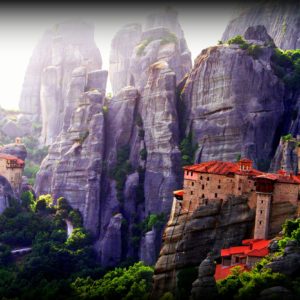Panagia Chalkeon
Panagia Chalkeon, also known as the “Red Church” due to its brickwork, is situated at the intersection of Egnatia and Aristotle streets. It is the sole church from the Middle Byzantine period that has survived in Thessaloniki. According to the foundation inscription on a marble plaque, it was built in 1028 AD by the military commander Christopher Longobardos and his family in honor of the Virgin Mary, on the site where a pagan temple once stood.
In 1430, during the Ottoman occupation, the church was converted into a mosque and named Kazandjilar (meaning “coppersmiths’ mosque”), as this area has been home to copper workshops since the Byzantine period. the current name “Panagia Chalkeon” – Virgin of the Coppersmiths. The Byzantine name could have been “Panagia Chalkopration,” similar to a church of the same name in Constantinople. After the liberation of Thessaloniki in 1912, the church returned to Christian worship. The earthquake of 1932 caused significant damage to the temple, which was restored in the 1930s, removing embankments that covered the entire lower level of the structure.
Panagia Chalkeon belongs to the type of four-columned cross-in-square churches, characterized by a central dome supported by four columns. On the western side, there is a two-story narthex with two domes. In the center of the northern side, a memorial for the church’s founder protrudes from the wall.
The church is entirely constructed using the Byzantine “hidden brick” technique, with exterior walls adorned with numerous windows, stepped arches, dentil bands, cornices, embedded half-columns, colonnades, and pillars.
The fresco decoration of the church corresponds to two different phases. According to an inscription in the sanctuary, the first phase coincides with the construction of the church and dates back to the second quarter of the 11th century (1030-1040). It includes dome paintings depicting the Ascension, the Virgin Mary, Hierarchy, and two scenes of the Eucharist, decorating the sanctuary, along with the majestic composition of the Second Coming. The second phase of frescoes took place in the 14th century.
In 1988, the church was included in UNESCO’s World Heritage List: UNESCO https://whc.unesco.org/en/list/456/.
The church is open for visitation daily from 08:00 to 12:00 and from 17:00 to 19:00.




